Backing Plate
The main purpose of a backing plate is three fold:
1. Distrubute the surface loading of the seacock (or other item) over a greater surface area to help with loading on the hull.
2. Prevents hard points where the seacock edge is adjacent to the hull which could induce cracking later on at the hard point.
3. Provides added thickness/meat for the bolts.
As an aside, backing blocks should be cicular as a square one has four hard points - the corners. This is a basic principal in aircraft design: never have square edges as they create hard points. They should also be thoroughly coated in epoxy - both sides.
Whether you drill a hole to secure the seacock or not is one's own decision, but the whole nature of a sea cock is to mechanically secure it to the hull.
As for how to get a flat block to mount to a curved hull, the correct process is to build up a hard material (i.e. epoxy and glass) to eliminate the radius. There's labor involved, but that's the correct way to do it. If the decsion is to use goo or thickened epoxy to do the job, well, that's better than nothing. The down side to all goo is that the expansion and contarction of the goo in a large gap is not the best scenario as it will eventually work. Nor can one be sure that all air bubbles have been removed.
As for thickened epoxy, the tightenming of the bolts will squeeze out the epoxy, unless one does it twice; once to let the epoxy set up, then remove item and add sealant. Then tighten down for good.
As for the seacocks I installed, they have a four-fold securing features:
1. The seacock is bolted to the circular wooden backing plate
2. The thruhull flange is screwed into the seacock
3. The backing plate is bolted to the hull
4. Goo is holding it all together
If that fails, I hit a whale.
Here is an in-between shot when I was building up the hull with epoxy and X-matt. The pieces were cut into doughnut - ovoid shaped pieces to get a flat surface to mount the backing plates to evenly.


